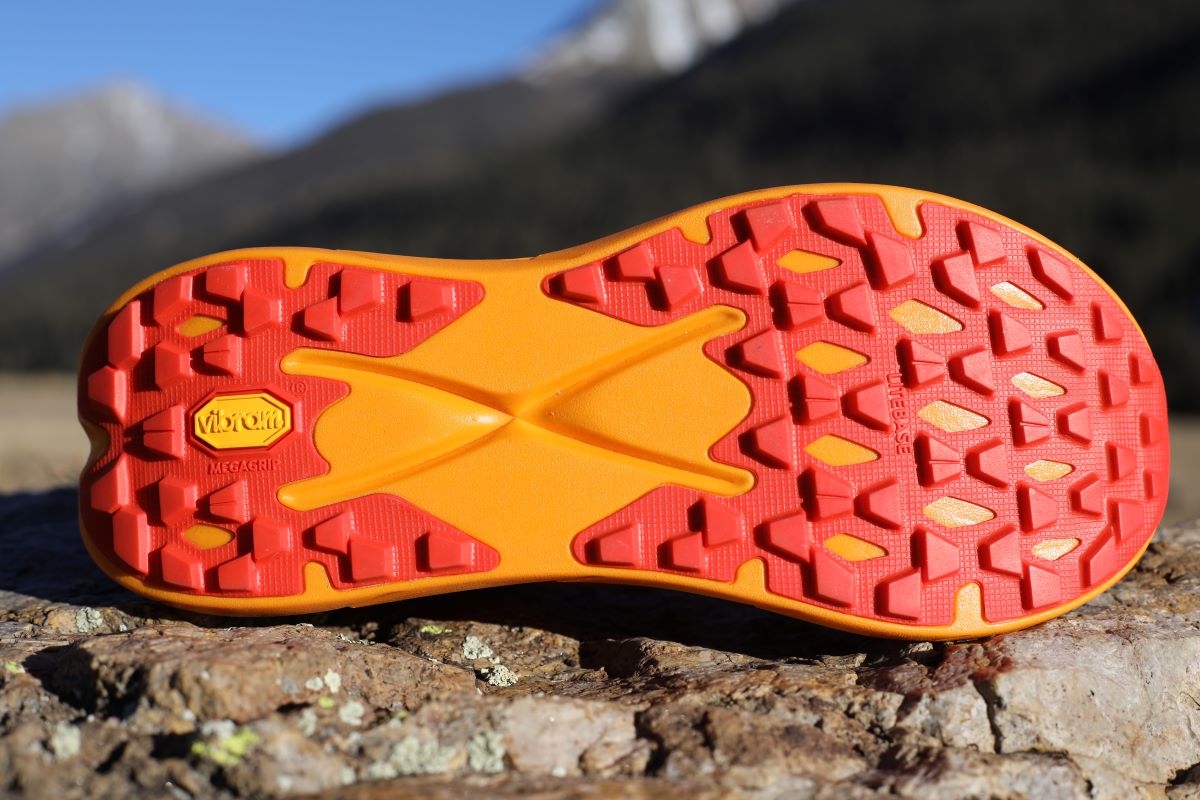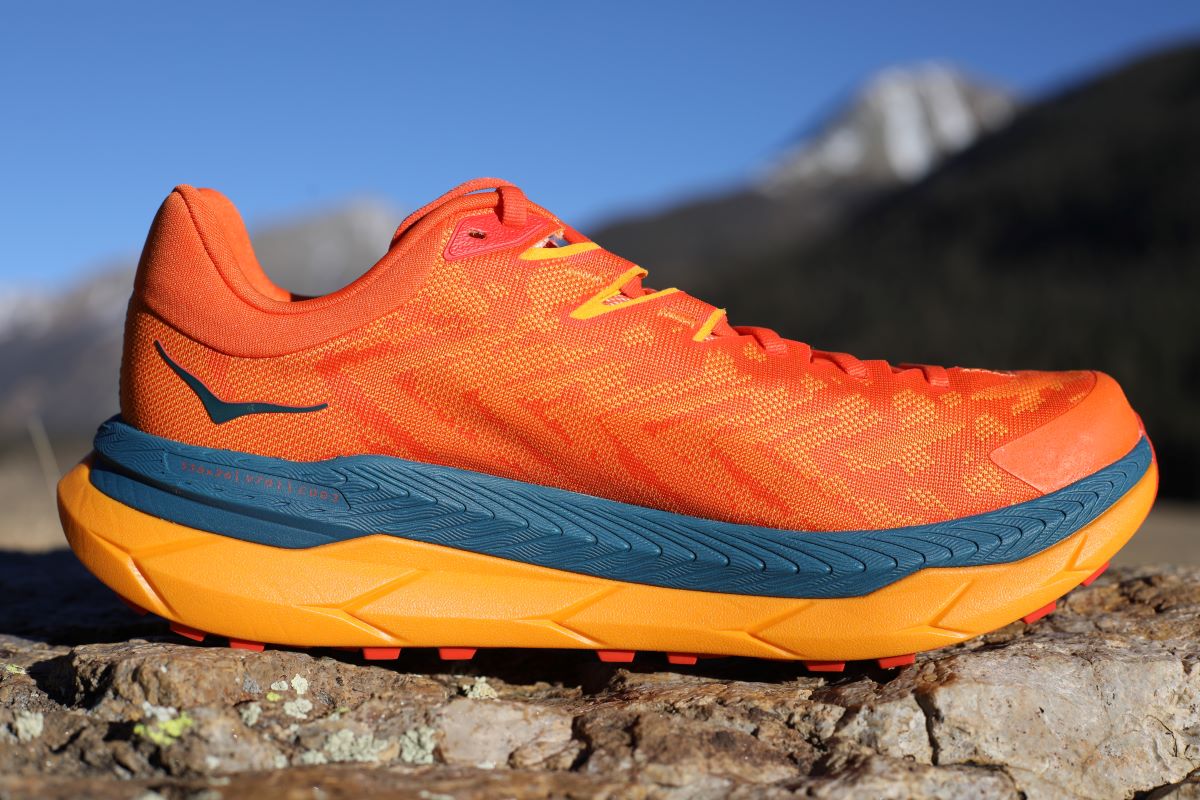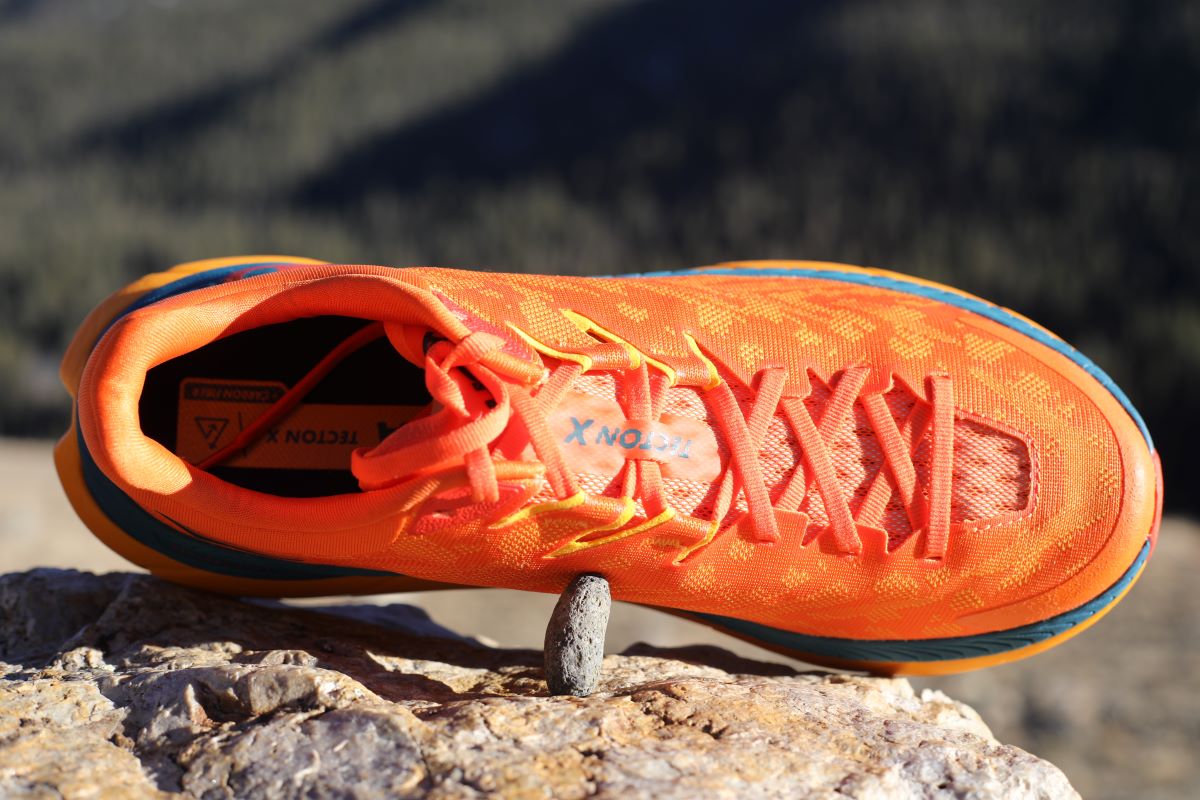For the latest on the Tecton X family, read our full Hoka Tecton X 2 review.
Our Favorite Trail Running Shoes
Check out our Best Trail Running Shoes buyer’s guide to learn about our current favorite trail running shoes!
Hoka Tecton X Review
With the Hoka Tecton X ($200), the brand brings its carbon plate technology into a lightweight trail running shoe. In this shoe, you’ll find a refined upper, twin carbon plates, and a Vibram Megagrip outsole. Our reviewer found it great on fast, smooth trails but felt it lacked the really secure lockdown needed for tackling more technical terrain at speed.
The iRunFar team loves this shoe enough that we named it one of the top shoes in our best cushioned trail running shoes guide.
Watch our detailed video review below to learn more about its strengths and weaknesses.
Shop the Men's Hoka Tecton XShop the Women's Hoka Tecton X
Hoka Tecton X Review Transcript
Hey, welcome to Trail Trials, the video review section of iRunFar.com. My name is Travis Liles and in this review, we’re looking at the Hoka Tecton X.
Hoka Tecton X Outsole
Let’s start off by talking about the Hoka Tecton X outsole. At the bottom, what you’re going to see is Vibram Megagrip, which is the Litebase version of Megagrip. And what that means is it’s really just a lighter-weight compound than the normal Vibram Megagrip. It’s used on higher-end trail running shoes that want to keep their weight down. And this definitely is an example of a higher-end trail running shoe that’s trying to stay on the lower spectrum of weight. In this case, the actual weight is sub-9 ounces (8.9 ounces, 252 grams) in a men’s size 9.
From a lug pattern standpoint, there are some varying lugs but for the most part, it has reverse lugs sitting at angles. Where you would do some braking, at the back of the shoe, you have three rows of these. And then when you switch to the front, those change. You’ve got front-facing lugs interspersed with a couple of different directional ones so it’s not all one or the other.
It’s a little bit of a mixed pattern but for the most part, these lugs are created in the way for braking downhill and, of course, grip going up. They are 4-millimeter lugs, they are not super, super deep. They are going to be your general-purpose lugs. They are going to grip on rocks, on bridges, and in dirt. They are not going to be really great for extreme depths of mud but that’s definitely not what the shoe is built for, so you shouldn’t have that expectation to begin with when you are going with his shoe.
At the bottom, where you’ll see a lighter orange color in the middle of the foot, there is exposed foam. It has held up fairly well, there are a couple of creases in some spots on the shoe. But it is done for weight-saving so you have less protection down here, less coverage, but it is meant for the sake of cutting weight on the shoe in general. Again you see this a lot, not only with Hoka but in the industry at large.
It is going to probably break down and doesn’t provide as much protection, even as the lightweight rubber elsewhere on the outsole, which is still going to provide some puncture protection. You are not getting that in the middle of your foot but in most cases, you are probably landing on a heel, or you are landing on the forefoot. So, your probability of hitting here, while not nonexistent, is less than these other spots. Just something to keep in mind, depending on the type of terrain that you plan on taking the shoe on.
But overall, this is a good outsole. I like Litebase, I really like Vibram Megagrip in general. It’s not spring here in the U.S. Pacific Northwest, so I can’t test in every condition but overall, I never really felt wanting for grip with this shoe in general. It’s a really good general-purpose cover of all the bases — not really specific driven type of outsole.
I guess the other thing I will add here, is that I wore the shoe a decent amount for road running because of the type of shoe that it is. This is the type of outsole that sort of gets out of the way, so you don’t have any big lugs or anything like that poking through when you are running on something flatter.
Hoka Tecton X Midsole
Next up, let’s talk about the Hoka Tecton X midsole. This uses a ProFlyX midsole, from Hoka. And what this is supposed to be is a firm foam with a very soft foam combined with it. So, the idea is you’ve got that sort of snap that makes it a little bit faster running, with that firm foam that’s going to give harder rubber, so the return is a little bit quicker. You sink less into it. But then it’s got some very soft foam added to it, a colored foam that adds that comfort for your foot, or that shock absorption.
So, you’re getting a little bit of both in terms of speed-to-comfort ratio. And I think if you compare this to something like, let’s say the Hoka Zinal — watch our Hoka Zinal review to learn more — this shoe has more of that softer feel to it, which is more Hoka I think than the Zinal. It fits more like an everyday trail running shoe.
The real play here that we’re going to talk about is something we can’t see, and which is the whole reason that this shoe is called the Tecton — and that’s inside of this midsole, there is a carbon plate. In fact, that there are two carbon plates, and they run parallel to each other inside of the shoe. So, a lot of carbon shoes tend to have one plate. When you step down, it creates bounce and adds energy and the shoe pushes down, and then when the plate pops up, it bounces your shoe and propels you forward.
That’s a little more dangerous, I would think, or at least in the shoes I have worn that are carbon plated, they are definitely more active-feeling than a standard road shoe. So, the goal here was to create two plates that ran side-by-side, with less of that punch of the carbon plate. And that’s going to run inside the shoe, kind of down the side.
The other thing that carbon plates are going to do are to act as a rock plate. Even though it’s carbon fiber, it’s still a rock plate that’s inside the shoe and in fact, this is a feature that’s been inside of trail running shoes for as long as I can remember.
So, that’s really the main showpiece here, something that you can’t see. And just in terms of feel, I think this foam works really well. It feels good, it feels active, it also feels like there’s enough foam. It doesn’t feel like a lightweight racing flat. It’s got this middle ground of being comfortable but also snappy, which I guess is what Hoka was going for, and I think achieved in this shoe.
Hoka Tecton X Upper
Next up, let’s take a look at the Hoka Tecton X upper. The lacing is really interesting, and to me was the thing I noticed before anything else. It’s a very, very low lacing system; it goes almost the whole way down to your toes. It reminds me a lot of a Danner boot in the way that it just keeps going and going. It is a really comfortable upper, which was one of the things I noticed early on with his shoe.
It’s all engineered mesh and there are really no overlays at all, with a slight exception of a little bit of rubberized area around the top upper lace, on both sides. Of locking my foot in, if I was to compare this shoe to the Hoka Speedgoat 5 — watch our Hoka Speedgoat 5 review for more on this shoe — this is a better lockdown than that shoe was. It’s less baggy, it’s more precise. It just fits better.
But what I don’t have on this upper is quite as much athletic lockdown as I would like. That is one of the downsides to me of the shoe is when I am cornering really hard, because there’s really nothing holding this shoe in place. It still, even with a good, secure fit, kind of moves around a lot on my foot. Or moves around enough that I notice it and to me, that’s the difference between a great upper and a good upper.
On a great upper, I don’t notice the fact that my foot is holding still. Whereas with a good upper, my foot is moving so then it is something that I think about when I do a hard cornering or jump a little bit and have to land hard. This is one where my foot does have some movement inside, and it just doesn’t lock down hyper good as I would like it to.
But overall, the direction here that this is going — lighter-weight upper, engineered mesh — it’s cool, it looks good, it looks modern. And it holds my foot in place for 90% of the things I want to do. And that’s in some cases going to be enough for most people.
Last couple of things here, we have a toe bumper. There’s some protection here, it’s part of the outsole. This is very, very hard right here at the tip. This is being brought up from the outsole. There’s some additional material here for some abrasion resistance around the toe, as well as creating just a little bit of structure for that toe cap.
The lacing system is I guess a little weird, just up at the top. I bring this up because of the heel lock. It’s got a fairly narrow to normal heel, it’s going to fall more toward the narrow to standard fit on the heel. It does have a slight bit of a heel cup, but as I’m examining the shoe, my thumb can squash that down fairly easily.
So, there’s a little bit of something in here that sort of runs around the heel. It’s enough to create some structure and to create an area for your foot to sit down and lock into, but it’s not so much that it’s rigid and you really notice it. The lacing system, in terms of the heel, I always use the back lace, and it’s a little weird as it has these wings that just flop out here. It doesn’t necessarily change much. It just doesn’t seem graceful.
I know that doesn’t matter, but aesthetically it’s this piece just sort of flopped around out here. If you don’t have to use it, it doesn’t matter. I have to use it and every time I put this shoe on there is this thing hanging up here. Anyway, that’s more of a preference, but for the most part, you do have a good fit out of the shoe.
Interesting lacing. I wish more shoes would do this pattern because it starts to take that lacing farther and farther down, and it gets it off of the top of your foot. And it moves it more toward the knuckle of your toes, which are going to sit lower than that upper part of your foot. So, I like this, I’m a fan of this, and I hope to see some of this progress.
Hoka Tecton X Overall Impressions
In closing, I think what you’ve got here in the Hoka Tecton X is a really great shoe and, for me, I have to put that in context — this is a really great shoe for my quiver. This is not a really great shoe for me to wear for everything. This to me is a shoe that has a specific area, when I want to go fast, when I don’t need as much protection, when I’m looking for a firmer ride.
When I’m not going to be in big mountain, technical things where very precise fitting and control are a must. Now is that because of the carbon plate? Maybe. I think some of it is the upper. The result of the removal of these overlays, for lighter weight, to me is lost lockdown. Your foot’s going to vary, it may lock down your foot perfect.
This locks better than the Hoka Speedgoat 5 does, but not enough to really feel confident that I can just go down something that’s going to have a lot of terrain differences and sharp rocks and things that I’ve got to navigate around at a quick cadence. This is a shoe for that quick cadence of fairly continual, consistent terrain or dirt path stuff with fewer obstacles. Stuff with fewer twists and turns and hard cornering, this is a great shoe for that. So, this is a little more purpose-driven for me.
So, you’ve got kind of an interesting proposition here. It’s more sturdy than the Hoka Zinal. Feels a little thicker, a little more cushioned. You’ve got a little more going on here overall than that shoe, but it’s not as much as a Hoka Speedgoat 5. So, sort of sitting in between those two.
And then you have got the carbon plate, which does add a little bit of snap, though I don’t have any scientific information to say if it is in fact providing that much. Because you’ve got geometry, and you’ve got fit, and you’ve got all these things that play into it. Regardless of what that is, the fact that we’re getting these types of technologies in our trail running shoes, to me, is awesome. It’s not just saved for the mass-market marathon type of shoe, we’re bringing that to trail running, we’re bringing that to our sport and I think that’s always really exciting.
Shop the Men's Hoka Tecton XShop the Women's Hoka Tecton X
Call for Comments
What’s your take on the Hoka Tecton X, and how do you feel about it? Are you using it for super-long-distance things? How do you deal with it on really technical terrain? What do you think about the carbon plate? Do you notice it? Or is it really just a rock plate and something that we’ve had in our trail running shoes for a while — we’re just using a different combination of materials to make that rock plate? Again, questions and comments, leave those below this review. Thanks for watching, we’ll catch you next time.





